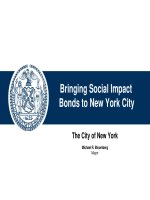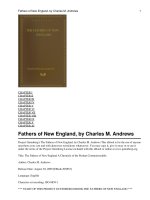The Botany of New Holland V2, Smith 1793
Bạn đang xem bản rút gọn của tài liệu. Xem và tải ngay bản đầy đủ của tài liệu tại đây (3.95 MB, 85 trang )
a
SPECIMEN
OF THE
B O T a N Y
OF
NEW
H O L L A N D,
BY
JaMES EDwarD SMITH, M. D. F. r. S.
MEMBEr OF THE rOYal aCaDEMIES OF TurIN, uPSal, STOCKHOlM aND lISBON;
COrrESPONDENT OF THOSE OF MONTPEllIEr aND DauPHINY, &c. &c.
PrESIDENT OF THE lINNÆaN SOCIETY.
D
D
THE FIGURES BY JAMES SOWERBY, F. L. S.
‘ ‘ Tendebantque manos ripæ ulterioris amore.’ ’
V .
<
V O l. I.
<
l O N D O N:
P r I N T E D B Y J. D a V I S:
PuBlISHED BY J. SOwErBY, NO. 2, MEaD PlaCE, laMBETH ; TO BE HaD
aT NO. 42, PaTErNOSTEr rOw, aND OF THE TOwN
aND COuNTrY BOOKSEllErS.
L
M.DCC.XCIII.
TO
THOMAS WILSON, ESQ. F. L. S.
AT WHOSE PERSUASION
THIS WORK WAS UNDERTAKEN,
AND
ON WHOSE FRIENDLY COMMUNICATIONS
IT IS FOUNDED,
THE FOLLOWING PAGES
ARE INSCRIBED
BY THE AUTHOR.
P r E F a C E.
A
attempt to make the Public acquainted with
some of the produtions of a country of which they
have lately heard so much, and in which they are
now as a nation so deeply intereted—a country too so
extremely unlike all those bet known to Europeans,
cannot fail to be acceptable, however imperfect in
its extent. The present work mut be considered only
as, what it pretends to be, a Specimen of the riches of this
mine of botanical novelty. It may inform the cultivators
of plants concerning what they have already obtained
from New Holland, as well as point out some other
things worthy of their acquisition in future. As the
author intends it for the use of his countrymen and
countrywomen, it is written in their own language—
a language every day growing more universal, and
which many circumtances now seem to point out as
likely to become the mot so of any modern one.
The
P r E F a C E.
viii
The essential charaters alone are given in Latin, as
well as in English. The igures are taken from coloured
drawings, made on the spot, and communicated to Mr.
Wilson by John White Esq. Surgeon General to the
Colony, along with a mot copious and inely-preserved
colletion of dried specimens, with which the drawings
have in every case been carefully compared.
December 1793.
1
Ta B. I.
BILLARDIER A scandens.
Climbing Apple-berry.
oooooooooooooooooo
PENTaNDrIa MONOgYNIa.
G. C. Petala quinque, foliolis calycinis alterna.
Netarium nullum. Stigma simplex. Bacca supera,
polysperma.
Petals ive, alternate with the leaves of the calyx.
Netary none. Stigma simple. Berry superior, with
many seeds.
S. C. B. pedunculis solitariis uniloris, foliis
subhirsutis.
Flower-stalks solitary, single-flowered. Leaves
somewhat hairy.
=
aMID all the beauty and variety which the vegetable produtions of New Holland display in such
2
profusion, there has not yet been discovered a proportionable degree of usefulness to mankind, at leat with
respet to food. This is our irt and mot natural enquiry
in a scene of such novelty ; but it is an enquiry natural to
all the lower orders of sensible beings, as well as to man.
It may perhaps mortify his pride to think how much more
quickly and certainly inferior animals judge upon such a
subjet. Their powers however reach no farther. It is the
peculiar privilege of reasoning man, not only to extend
his enquiries to a multiplicity of attainable beneits to
himself and his species, besides the mere animal necessity
of food, but also to walk with God through the garden
of creation, and be initiated into the diferent plans of
his providence in the contrution and œconomy of all
these various beings ; to tudy their dependencies upon
one another in an ininitely complex chain, every link of
which is essential ; and to trace out all those various uses
and beneits to every branch of the animal creation, of
which each animal is a judge only for himself. In this
point of view no natural prodution is beneath the notice
of the philosopher, nor any enquiry triling under the
guidance of a scientiic mind.
In compliance however with those who do not look
so deep into natural knowledge, we here introduce to
their acquaintance almot the only wild eatable fruit of
the country we are about to illutrate. It may serve as
an olive-branch, to procure their patience as we proceed
3
together hereafter through the consideration of less
conspicuously intereting objets. Nor will the scientiic
botanit ind the plant before us unworthy of his mot
accurate attention.
Its genus is easily charaterised in the Linnæan sytem
by the many-seeded berry above the lower, and may
tand somewhere between Escallonia and Mangifera. We
cannot certainly tell what genera are its natural allies,
especially as we have no knowledge of the fruit and seeds
except from a drawing. May it be akin to the Capparides
of M. de Jussieu ?
The name Billardiera is given it in honour of James
Julian la Billardiere, M. D. F. M. L. S. now engaged as
botanit on board the French ships sent in search of M.
de la Peyrouse. His icones Plantarum Syriæ rariorum, the
fruits of a journey to the Levant in 1786, jutly entitle
him to such a ditintion.
We have acquired two species of this genus from New
South Wales. The root of the present is woody and
zigzag, with a reddish inner bark. Stems several, twining
among other shrubs, branched, woody, round, downy
when young, detitute of leaves except on the young
branches. Leaves alternate, sessile, lanceolate, bluntish,
motly entire, but undulated and revolute in such a
manner as to appear dentated, which they sometimes
really are, paler beneath, slightly veined, mot hairy
when young. Stipulæ none. Flowers solitary, enveloped
4
in long leaves, terminating the young branches, on
short downy foottalks, drooping, of a pale lemon-colour,
without brateæ. Calyx regular, of ive equal, narrow,
pointed, leaves, hairy and ciliated. Petals ive, twice as
long, equal, lanceolate, pointed, attenuated at the base,
inserted into the receptacle. Stamina ive, as long as the
calyx, and opposite to it, equal, subulate, smooth. Antheræ
arrow-shaped. Germen altogether superior, oblong, very
hairy. Style short, eret. Stigma simple. Berry cylindrical,
yellow, very obtuse at both ends, downy, terminated by
the permanent tyle, and said to have a very ine lavour,
not unlike a roated apple. Seeds numerous, horizontal,
blackish.
EXPl aNaT ION
1.
2.
3.
4, 4.
5, 5.
6.
OF
TaB. I.
Calyx.
A Petal.
Stamina and Pitillum.
Ripe Fruit.
Foottalks.
Seeds.
5
Ta B. I I.
TETR ATHECA juncea.
Rushy Tetratheca.
oooooooooooooooooo
OCTaNDrIa MONOgYNIa.
Fl. complete.
G. C. Cal. quadriidus, inferus. Cor. tetrapetala.
Capsula bilocularis, bivalvis ; valvulis medio septiferis.
Semina subbina.
Cal. four-cleft, inferior. Cor. of 4 petals. Caps. of
two cells and two valves, with the partition from
their middle. Seeds about two in each cell.
S. C. T. glabra, foliis alternis lanceolatis, caule
acutangulo, ramis elongatis nudiusculis.
Smooth. Leaves alternate, lanceolate. Stem with
sharp angles. Branches elongated, and almot naked.
=
TO this pretty genus, three species of which have
been sent from New South Wales, we have given the
name Tetratheca, on account of the curious truture of
6
its antheræ, each of which consits of four cells, communicating with one common tube, the excretory dut of the
pollen. In the contrution of this name we run counter
indeed to a precept of Linnæus (Crit. Bot. p. 44), and we
do so because in that intance we think him in the wrong.
After objeting, with reason, to generic names too similar
in sound to each other, he is somewhat unmerciful in
tigmatizing almot all that have any syllables in common,
and wonders at Vaillant for using the termination theca at
all. The word surely in itself is unexceptionable ; and as
all the generic names of Vaillant contruted with it, even
Tetragonotheca (which Linnæus at irt retained), are now
laid aside, and therefore there can be no ambiguity, we
hope to be excused for adopting theca, as it so precisely
suits our purpose.
Tetratheca probably belongs to M. de Jussieu’s order of
Ericæ, not indeed that it answers well to his charaters
of that order, but it is allied to some of its genera, especially Pyrola. All its species are small shrubs with red
lowers ( varying to white ), which retain their colour
when dried.
Tetratheca juncea has a small woody root, which has
some appearance of that of an annual plant. The tem is
much branched, even from the base ; the branches alternate, long and slender, very acutely triangular, and almot
winged. Leaves motly small and not numerous, alternate,
lanceolate, entire. Stipulæ none. Each branch produces
a simple series of drooping lowers, in a racemose order,
7
on simple capillary red foottalks, with a small leaf at the
base of each. Calyx deeply cloven, obtuse. Petals obovate,
crimson, paler on the outside, entire. Stamina equal ; the
ilaments very short ; antheræ slightly curved, with four
blunt angles, and four furrows, brown, tipped with a pale
simple tube, into which the four cells of the anthera open.
Germen very small, obovate, compressed. Style short and
simple. Capsule pendulous, obovate, compressed, pointed.
Seeds two in each cell, one above the other, cylindrical,
tanding on a white twited pedicle.
Every part is smooth. We have specimens of a variety
with white petals, but the calyx and foottalk remain
red.
EXPl aNaT ION
1.
2.
3.
4.
5.
6.
7, 7.
OF
Calyx and Foottalk.
Petal.
Stamina.
A Stamen magniied.
The same cut across.
Capsule.
Seeds.
TaB. II.
9
Ta B. I I I.
CER ATOPETALUM gummiferum.
Three-leaved Red-gum Tree.
oooooooooooooooooo
DECaNDrIa MONOgYNIa.
G. C. Cal. 5-partitus, taminiferus, persitens.
Petala 5, pinnatiida. Antheræ calcaratæ. Caps. in
fundo calycis, teta, bilocularis.
Cal. 5-cleft, bearing the tamina, permanent. Petals
5, pinnatiid. Antheræ with a spur. Caps. in the
bottom of the calyx, covered, two-celled.
=
wHEN a botanit irt enters on the invetigation
of so remote a country as New Holland, he inds himself
as it were in a new world. He can scarcely meet with
any certain ixed points from whence to draw his analogies ; and even those that appear mot promising, are
frequently in danger of misleading, intead of informing
him. Whole tribes of plants, which at irt sight seem
10
familiar to his acquaintance, as occupying links in Nature’s
chain, on which he has been accutomed to depend, prove,
on a nearer examination, total trangers, with other
conigurations, other œconomy, and other qualities ; not
only all the species that present themselves are new, but
mot of the genera, and even natural orders.
The plant before us jutiies the above remarks. Its
botanical charaters are so new, we can scarcely tell to
what tribes it is allied ; and although, from the peculiar
felicity of the Linnæan sexual sytem, founded on parts
which every plant mut have, we are at no loss to ind its
class and order in that which is an artiicial sytem, we
till scarcely know what genera are its natural allies. It,
however, seems mot nearly related to Ditamnus and
Ruta, of all the Decandria Monogynia, and may be safely
inserted near them. We dare not positively say it belongs
to M. De Jussieu’s natural order of Rutaceæ, but for the
present it may be so considered, till future discoveries,
shall authorise us to contitute a new one. The generic
charater above given certainly ditinguishes it from all
other genera, and the name applies to the very unusual
horn-like divisions of the petals, like those in the leaves
of the Ceratophyllum of Linnæus. One species only is
already known.
This, Mr. White informs us, is one of the trees (for
there are several, it seems, besides the Eucalyptus resinifera,
mentioned in his Voyage, p. 231.) which produce the red
11
gum. He further remarks, that it is the only wood of the
country that will swim in water.
The tree is of a considerable height, upright, much
branched, and of a beautiful appearance when the lowers
are come to maturity, or rather about perfeting their
seed, as in the specimen here igured. Every part is quite
smooth. Branches opposite, round, slightly angular at
the top. Leaves opposite, on foottalks, ternate. Lealets
sessile, nearly equal, lanceolate, obtuse, serrated, veiny,
shining, paler beneath. Stipulæ none. Panicles terminal,
irt oppositely, and then alternately branched, with a
small pointed glutinous bratea at the base of each partial
lower-talk. Flowers at irt expanding small but the
calyx afterwards becomes much enlarged, whitish, tinged
with red, and all their parts continue permanent till the
fruit is ripe. The Calyx is inferior, ive-cleft ; its segments
lanceolate, acute, slightly ribbed ; its margin at the base of
the segments surrounded with a ring bearing the petals
and tamina, as in icosandrous plants. Petals alternate
with its segments, at irt equal to them in length, then
much shorter, irregularly and unequally pinnatiid ; their
divisions linear and acute. Stamina shorter than the
petals, awl-shaped. Antheræ roundish, of two oval cells,
and with a spur at their base. Germen in the bottom of
the calyx, globular, ten-ribbed. Style awl-shaped, short.
Stigma cloven, acute. Capsule in form like the germen,
small, with a coriaceous covering, originally two-celled,
12
but one side seems always abortive, and the seed in the
other pushes the partition from the centre. We have
only seen the fruit half ripe, and the imperfet seeds were
withered, but they appear to be solitary.
EXPl aNaT ION
OF
TaB. III.
1. A bunch of young lowers, of their
natural size.
2. The more advanced calyx laid open, with
its petals and tamina in their proper
situations.
3. A petal and tamen separate.
4. The same magniied.
5. Back of the ilament and anthera.
6. Germen in a young tate.
7. Its coriaceous covering.
8. Stigma.
9. Germen somewhat farther advanced, cut
across to shew the cells.
13
Ta B. I V.
B A N K S I A spinulosa.
Prickly-leaved Banksia.
oooooooooooooooooo
TETraNDrIa MONOgYNIa.
G. C. Receptaculum commune elongatum, squamosum. Cor. tetrapetala. Stamina limbo inserta.
Capsula bivalvis, disperma, interjeto seminibus
dissepimento mobili.
Common receptacle elongated, scaly. Cor. of 4 petals.
Stamina inserted into the limb. Capsule with two valves,
two seeds, and a moveable partition between them.
S. C. B. foliis linearibus revolutis mucronulatis
apicem versus denticulato-spinosis.
Leaves linear, revolute, with a little sharp point, and
with spinous denticulations towards the top.
=
THIS hitherto non-descript species of Banksia has
a woody branched tem, the branches commonly three
or more together, curved upwards. Leaves irregularly
scattered, closely covering the branches, on very short
foottalks, but little spreading, from an inch and half
to two inches in length, linear, very narrow, revolute in









